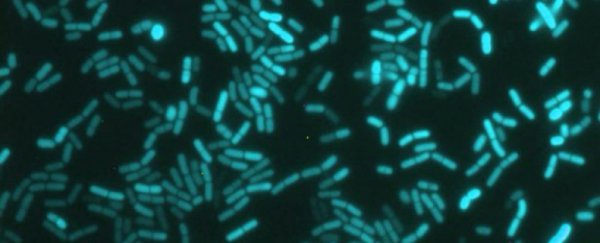In a first-of-its-kind discovery, scientists have found that a species of non-photosynthetic bacteria are regulated by the same circadian rhythms that hold sway over so many other life-forms.
In humans, our circadian rhythms act as a kind of biological clock in our cells, controlling virtually all the processes in our bodies, influencing when we sleep and rise, plus the functioning of our metabolism, and cognitive processes.
This internal time-keeping, which revolves around a 24-hour cycle, is driven by our circadian clock, and the same core phenomenon has been observed in many other kinds of organisms as well, including animals, plants, and fungi.
For a long time, however, it's been unclear whether bacteria at large are also subject to the dictates of circadian rhythms.
The phenomenon has been demonstrated in photosynthetic bacteria, which use light to make chemical energy, but as for whether other kinds of bacteria also possess circadian clocks has long remained a mystery – until now.
"We've found for the first time that non-photosynthetic bacteria can tell the time," explains chronobiologist Martha Merrow from the Ludwig Maximilian University of Munich.
"They adapt their molecular workings to the time of day by reading the cycles in the light or in the temperature environment."
In a new study, Merrow and fellow researchers examined Bacillus subtilis, a hardy, well-studied bacterium found in soil and the gastrointestinal tracts of many animals, including humans.
While B. subtilis is not photosynthetic, it is sensitive to light thanks to photoreceptors, and previous observations of the microbe have given clues that its gene activity and biofilm formation processes might follow a daily cycle in response to environmental cues, perhaps based around light levels or temperature changes.
To investigate, the researchers measured the bacterium's gene expression activity in cultures exposed to either constant darkness or an alternating daily cycle of 12 hours of light followed by 12 hours of darkness.
In the alternating light/dark cycle, expression of a gene called ytvA – which encodes a blue light photoreceptor – increased during the dark phase and decreased during the light phase, indicative of processes of entrainment in a circadian clock.
When subjected to constant darkness, the cycle still existed in B. subtilis, although the period lengthened, not strictly following a 24-hour cycle without the light signal to go off.
In another experiment, the researchers experimented with temperature cycles, which is another way to stimulate changes in heat between day and night.
Again, expression of ytvA ebbed and flowed as temperatures cycled between 12 hours at 25.5°C (77.9°F) and 12 hours at 28.5°C (83.3°F), and, as with light, the cycle persisted in a free-running experiment (not synchronised to environmental cues) although with a longer period.
Taking all the results together, the researchers conclude B. subtilis has a circadian clock, exhibited by free-running circadian rhythms and systematic entrainment to environmental cues known as zeitgeber cycles.
While the findings only pertain to one bacterial species for now, it's the first time this phenomenon has been in any non-photosynthetic bacteria, which could have vast implications for our understanding of bacteria as a whole: organisms that account for roughly 15 percent of the living matter on Earth.
"Our study opens doors to investigate circadian rhythms across bacteria," says circadian rhythms researcher Antony Dodd from the John Innes Centre in the UK.
"Now that we have established that non-photosynthetic bacteria can tell the time we need to find out the processes in bacteria that cause these rhythms to occur and understand why having a rhythm provides bacteria with an advantage."
For now, the team speculates the circadian rhythms may somehow be regulated by a transcription-translation feedback system, or could be tied to metabolic cycles.
It's also unknown whether one form of overall 'master clock' might somehow control B. subtilis's circadian time-keeping, as has been suggested in humans, although the team points out it is a possibility.
"It will be informative to investigate whether temperature and light are inputs to one master pacemaker, or whether B. subtilis might have multiple oscillators, as described for a variety of unicellular and multicellular organisms," the authors write in their paper.
"It is also possible that B. subtilis might have either a master oscillator or one or more downstream oscillators that are coupled to and entrained by a main pacemaker."
In any case, the ramifications of a 24-hour body clock in bacteria could have huge ramifications – not just in terms of scientific understanding of bacterial biology, but also in its potential utilisation in biomedical science, agriculture, industry, and beyond.
"Bacillus subtilis is used in various applications from laundry detergent production to crop protection … [and] human and animal probiotics," says bioengineer Ákos Kovács from the Technical University of Denmark.
"Thus engineering a biological clock in this bacterium will culminate in diverse biotechnological areas."
The findings are reported in Science Advances.
